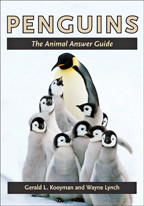
Johns Hopkins UniversityEst. 1876
America’s First Research University
Wild Thing: Discovering the hybrid world of penguins

Wild Thing is an occasional series where JHU Press authors write about the flora and fauna of the natural world—from the rarest flower to the most magnificent beast. Guest post by Gerald L. Kooyman

Not until 1969 was I able to pursue a simple experiment with the birds. I had discovered an ideal place and moment to determine to what depth the birds were diving while foraging offshore from Cape Crozier. This is another place full of history where members of the Robert F. Scott Discovery Expedition of 1901 to 1904 discovered the first emperor penguin colony in 1902. During that expedition Scott and two companions, one of whom was Ernest Shackleton, made the first attempt ever to trek to the South Pole. The Cape Crozier colony was the seed for Edward Wilson to organize a traverse from McMurdo Sound to the Cape during the winter of 1908 with two companions. One of those companions was Apsley Cherry-Garrard, who wrote the famous book Worst Journey in the World. This took place during Scott’s second expedition from 1910 to 1913. Under the cliffs of Cape Crozier we performed a successful experiment and learned that the birds were diving to at least 265 m (870 ft). That record remained as the world record for diving birds until the mid-1980’s when I was finally able to devote several entire expeditions to the study of king and emperor penguins.
Since then I have led or collaborated on many studies of king and emperor penguins, so my perspective, as I embarked on writing Penguins: The Animal Answer Guide, had a large penguin species orientation. There is not a species of penguin, past or present, that I have not enjoyed reading and writing and learning about. I would not have guessed, for example, that this remarkable group’s beginnings may reach as far back as the dinosaurs. If their success as a group, the Sphenisciformes, is measured in terms of longevity (and consider there are many more extinct penguins than those species that currently exist) and also in terms of the abundance of individual species, then penguins are one of the most successful air-breathing vertebrate groups. They were, that is, until the hand of man placed a heavy burden on them. There are now four endangered species among the seventeen currently described species. Some of the others are sliding down the slippery slope of survival in the face of humankind's expanding habitat and resource needs. I respond to several related conservation questions in the book.




